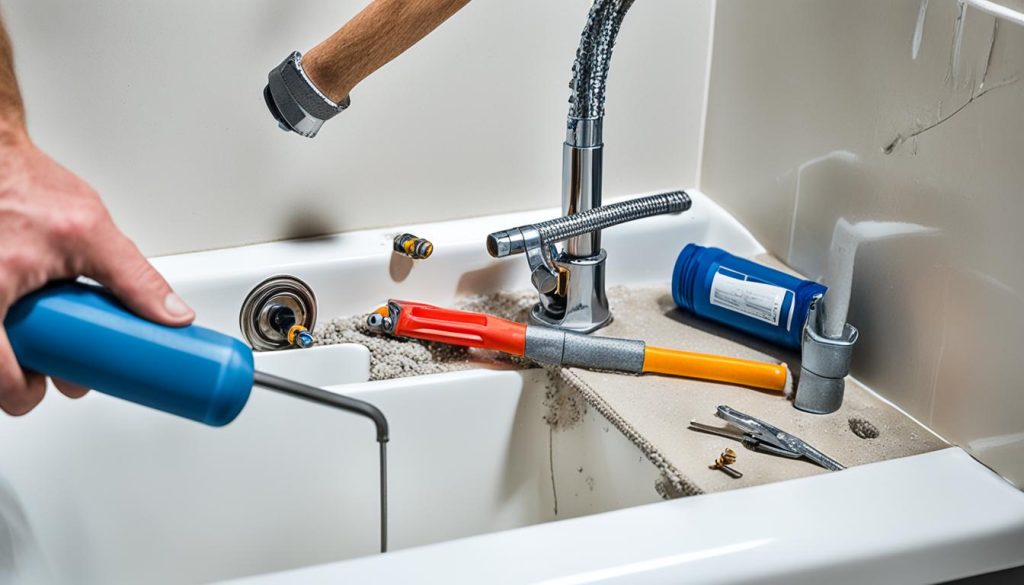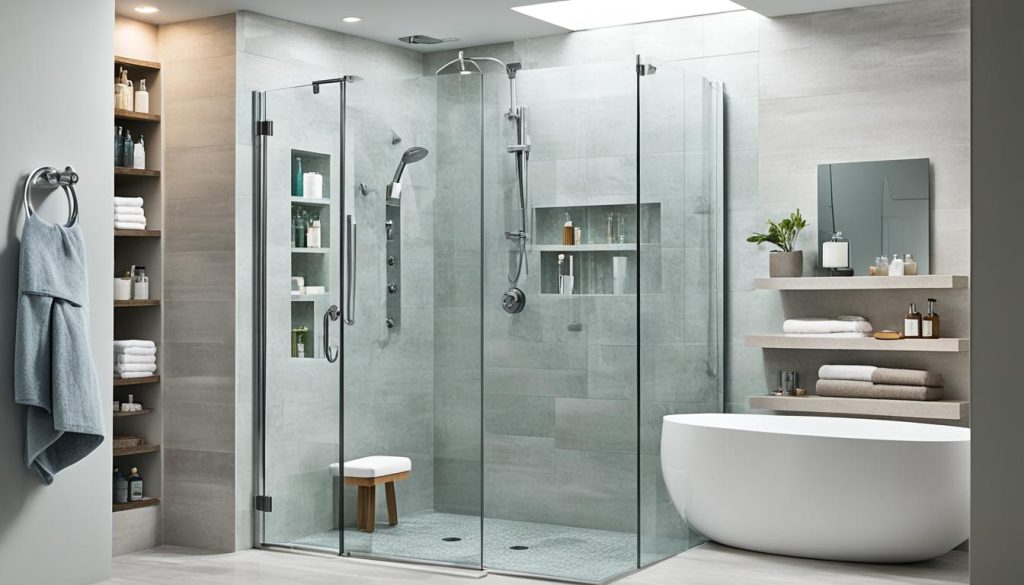Easy Tub to Shower Drain Conversion Guide
Whether you’re looking to update your bathroom or maximize your space, a tub to shower drain conversion can be a game-changer. Not only does it make your bathroom feel larger and more open, but it also offers practical benefits, like increased accessibility and easier maintenance.
In this easy tub to shower drain conversion guide, I’ll walk you through the steps and provide you with all the information you need to successfully complete this rewarding home improvement project. From choosing the right shower kit to the installation process, I’ve got you covered.
Key Takeaways:
- Converting a tub to a shower drain can create more space and make your bathroom feel larger and more open.
- A tub to shower conversion offers practical benefits like increased accessibility and easier maintenance.
- Choosing the right shower kit is crucial for a successful conversion.
- Converting a tub to a shower drain involves careful planning, demolition, and installation.
- Considerations like shower floor slope, shower door or curtain, and shower floor material are important for a functional and aesthetically pleasing result.
Benefits of Tub to Shower Drain Conversion
Converting your tub to a shower drain offers several benefits for your bathroom renovation. It can create more space in your bathroom, making it feel larger and more open. A shower installation is also a more practical choice for many people, as it is easier and quicker to use than a bathtub. Additionally, a tub to shower conversion can increase the accessibility of your bathroom, making it easier for individuals with mobility issues to use.
By converting your tub to a shower drain, you can maximize the functionality and aesthetics of your bathroom. Whether you’re looking for a change in your daily routine or planning a home improvement project, a tub to shower conversion can provide the following benefits:
- Increased space: Removing the bathtub and replacing it with a shower can free up valuable floor space in your bathroom. This can make the room feel more spacious and open, allowing for easier movement and a more enjoyable shower experience.
- Quicker and easier showering: Showers are generally quicker and easier to use compared to tubs. With a shower installation, you can save time on filling and draining the tub, making your daily shower routine more convenient and efficient.
- Improved accessibility: For individuals with mobility challenges or aging in place considerations, a tub to shower conversion can greatly improve the accessibility of your bathroom. Showers typically have lower thresholds, making it easier to step in and out safely. Additionally, the addition of grab bars and other accessibility features can further enhance safety and convenience.
Overall, a tub to shower drain conversion can transform your bathroom into a more functional and accessible space. Whether you’re looking to create a spa-like retreat or simply upgrade your bathroom’s design, this home improvement project can be a worthwhile investment.
Choosing the Right Shower Kit
When converting your tub to a shower drain, using a prefabricated shower kit can simplify the process. These kits are available in one- and multi-piece units, made of fiberglass or acrylic. It is important to choose a kit that fits your specific needs, taking into consideration the size of your bathroom and any potential limitations such as narrow staircases or doorways. Be sure to follow the manufacturer’s instructions for installation and any additional requirements, such as the need for mortar beneath the unit for stabilization.
By opting for a shower kit, you can save time and effort in sourcing individual components and ensure compatibility. These kits typically include the shower pan, walls, and any necessary accessories. Whether you are a DIY enthusiast or planning to hire professional plumbing services, a prefabricated shower kit provides a convenient solution for your tub to shower drain conversion.
Steps to Convert a Tub to a Shower Drain
Converting a tub to a shower drain involves several steps. Firstly, you need to plan the outline of your shower, taking into account the dimensions of your tub and the spacing requirements for a walk-in shower. Next, you will need to choose a walk-in shower design, such as curbed or curbless. It is important to obtain the necessary permits before starting any demolition work. Once you have obtained the permits, you can proceed with turning off the water supply, removing wall sections, and disconnecting plumbing fixtures. The next step is to remove the tub itself, either by lifting it away from the wall or cutting it into pieces. Finally, you can install your new shower, following the manufacturer’s instructions or hiring a professional for more complex tasks.
Converting a tub to a shower drain requires careful planning and execution to ensure a successful remodel. Below is a detailed breakdown of the steps involved:
- Plan the outline of your shower to determine the best location and size for your new shower. Consider the dimensions of your tub and the spacing requirements for a walk-in shower.
- Choose a walk-in shower design that suits your needs and preferences. Options include curbed showers, which have a small step to enter, and curbless showers, which provide seamless accessibility.
- Obtain the necessary permits from your local authorities before starting any demolition work. Compliance with regulations ensures the safety and legality of your project.
- Turn off the water supply to the bathroom. This step is vital to prevent any water leakage or damage during the conversion process.
- Remove wall sections as needed to create space for the new shower. Take extra caution when working with electrical wiring or plumbing connections.
- Disconnect plumbing fixtures, including the tub drain, faucets, and any other components that need to be replaced or relocated.
- Remove the tub itself from the bathroom. Depending on its configuration and accessibility, you may either lift it away from the wall or cut it into manageable pieces for disposal.
- Install your new shower according to the manufacturer’s instructions. This may involve assembling and securing the shower base, attaching walls or enclosure panels, and connecting the plumbing fixtures.
- After completing the installation, test the shower for any leaks or malfunctions. Make any necessary adjustments or repairs to ensure proper functionality.
- Clean up the work area and dispose of any debris from the conversion process.
Whether you tackle the conversion yourself or hire plumbing services, following these steps will help you successfully convert a tub to a shower drain and achieve your desired shower remodel.
Considerations and Tips for Tub to Shower Conversion
When planning a tub to shower conversion, there are a few key considerations to keep in mind. Ensuring a successful shower installation and remodel requires careful attention to detail and thoughtful decision-making. Here are some important factors to consider:
Sloping the Shower Floor
One crucial aspect of a tub to shower conversion is ensuring that the shower floor has the correct slope to direct water into the drain. This will prevent water from pooling and ensure effective drainage. An improperly sloped shower floor can lead to water damage and mold growth, so it’s essential to get this right. You can consult a professional or follow specific guidelines and resources to ensure the correct slope is achieved.
Choosing the Right Shower Door or Curtain
The type of shower door or curtain you choose can make a significant difference in the functionality and aesthetics of your new shower. Consider factors such as space availability in your bathroom and the clearance needed for the door or curtain to open and close smoothly. Additionally, think about the level of privacy you desire and the ease of maintenance for different materials. It’s essential to select a door or curtain that complements your overall bathroom design.
Selecting the Right Shower Floor Material
The choice of shower floor material can impact both the accessibility and visual appeal of your converted shower. Two popular options are curbed and curbless shower floors. A curbed shower floor typically has a raised edge, which helps contain water within the shower area. On the other hand, a curbless shower floor offers a seamless transition from the bathroom floor to the shower, providing easier accessibility for individuals with mobility challenges or those who use mobility aids. Consider the pros and cons of each option based on your specific needs and preferences.
If you’re unsure about any aspect of the tub to shower conversion process, it’s advisable to consult with a professional. They can provide expert guidance and ensure that your shower installation meets all plumbing and building code requirements. Hiring a professional for complex tasks can save you time, stress, and potential mistakes.
Remember, a successful tub to shower conversion involves careful planning, thoughtful decision-making, and precise execution. By considering these tips and seeking professional assistance when necessary, you can create a beautiful and functional shower space in your bathroom.
DIY Tub to Shower Conversion vs Hiring a Pro
When it comes to converting your tub to a shower, you may be wondering whether to tackle the project yourself or hire a professional. Both options have their pros and cons, so it’s important to consider a few key factors before making a decision.
DIY tub to shower conversions can be cost-effective, allowing you to save money on labor costs. However, they require plumbing skills, knowledge of demolition techniques, and some advanced DIY experience. If you’re confident in your abilities and have the necessary tools, taking on the project yourself can be a rewarding home improvement endeavor.
On the other hand, hiring a professional plumber for your tub to shower conversion can ensure that the job is done correctly and efficiently. This is especially important if you only have one bathroom in your household and can’t afford any mistakes or delays. A professional can handle the plumbing aspects of the conversion, ensuring proper drainage and water supply.
Ultimately, the decision between a DIY tub to shower conversion and hiring a pro depends on your budget, time availability, and skill level. If you have the necessary expertise and are comfortable with the project’s complexity, DIY may be a great option. However, if you’re unsure about your abilities or require a more polished finish, it’s best to leave it to the professionals who specialize in plumbing services for home improvements.
- Investing Wisely: How Windows & Doors in Boost Property Value and Financial Health - April 24, 2025
- The Financial Impact of Personal Injuries: Why Legal Help Matters for Business Owners - April 16, 2025
- The Hidden Financial Costs of Domestic Assault: What Business Owners Need to Know - April 16, 2025














